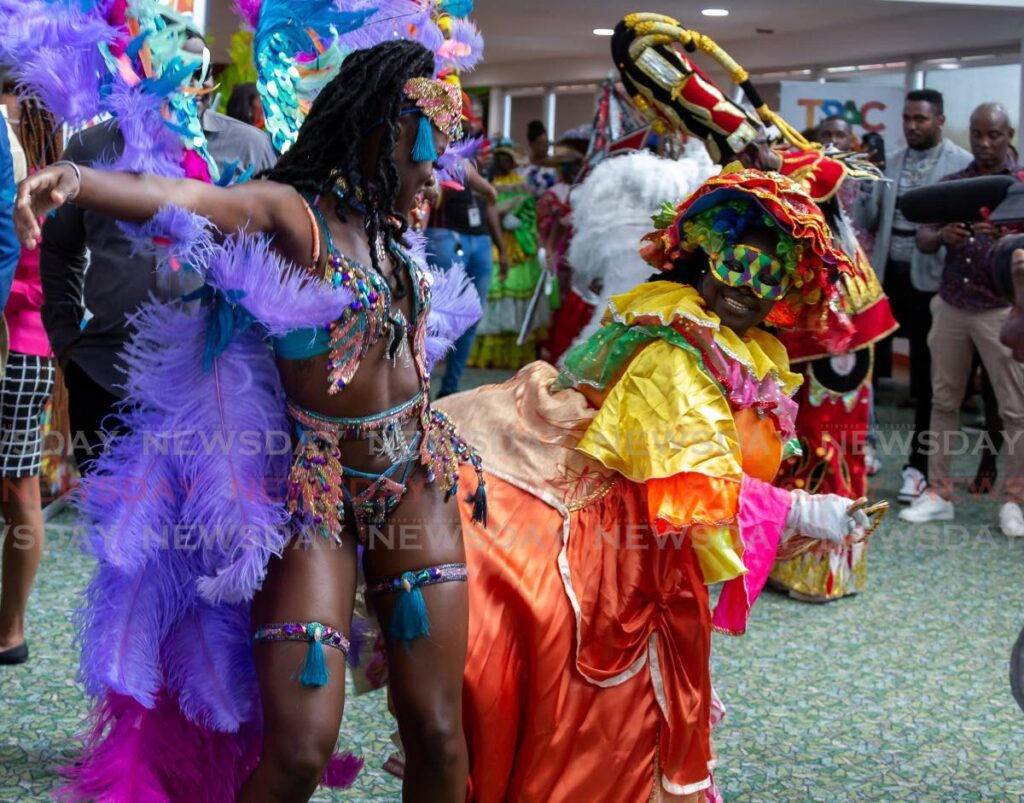Will the real Dame Lorraine please stand up?

Once Upon a J’Ouvert: part two of a three-part series by Sonja Dumas
If you’ve ever witnessed traditional mas, one of the first characters that might come to mind is the Dame Lorraine.
Nowadays it’s usually played by a woman, whose form highlights distended breasts and buttocks under a long dress, possibly layered with a second full skirt or maybe with a full petticoat below. She has a domino (half-mask) on her face and perhaps holds a fan or umbrella, or sports a hat with a generous brim.
Her outfit is anachronistic – it belongs to the nineteenth century – and there is a strong sense of buffoonery. There is a specific traditional tune that oozes pomposity and accompanies the Dame Lorraine, although these days the character is seen mostly in Carnival competitions and therefore parades across the stage to whatever soca song is playing.
The first major thing to consider is the pronunciation of the term “Dame Lorraine.” It is French in origin and Caribbean in usage. So the first word is pronounced “dam,” as the French would pronounce it, meaning “lady.” We pronounce the second word, also French, “Lo-RAIN” in Standard English, or “Lo-REN” in Creole, with the accent on the second syllable, but without the throat-rolling of the “r,” as they would do in classic French.

And why is French used in the first place? Because our Carnival ethos is rooted in French Catholic tradition. Catholicism was introduced by the Spanish and the word “Carnival” comes from carne vale, a term with roots in Latin, loosely translated as “farewell to the flesh.”
However, according to anthropologist Daniel J Crowley, it was the French Catholics who, from the 1780s, made the significant carnivalesque intervention in Trinidad, allowing people to indulge in debauchery before the austere period of Lent in the Christian calendar. From Christmas to Carnival Tuesday, they could indulge in carnal desires, excessive behaviour and lewd moments, exorcising those undesirable traits from their systems in preparation for repentance.
So Carnival activity consisted of extensive feting and bacchanal then – as it does now – albeit in different forms.
If you read the first part of this series, you’ll know that I discuss African interpretations of Carnival. These are what gave us the root of how our current Carnival is imagined and portrayed.
So the second major thing to consider is that the original Dame Lorraine was a performance by groups of recently emancipated African people, and it wasn’t a singular character or a band of people in the same costume. It was a satirical performance of the colonial period – yet another gesture of resistance on the part of the Africans.
This time, it was in the form of extreme lampooning of the colonial hierarchy. The Africans would create costumes from repurposed materials which imitated the Europeans, and they would poke fun at them by donning exaggerated body parts.

Raymond Quevedo, the popular calypsonian who went by the sobriquet Atilla the Hun in the Golden Age of calypso, wrote about it in the official 1958 Trinidad Carnival Magazine. According to him, there was a sort of MC called either Mâitre d’Ecole or Mâitre de Canton – “Schoolmaster” or “Master of the Prefecture” – who would introduce the characters one by one in a satirical ball – one that imitated the grand balls that took place in the European great houses.
Characters included “M’sieu Gros Boudin (Mister Big Belly), M’selle Fes Sel (Miss Singlecheek), Shuiss Bouchon (Cork-thigh), and Petit Jamb Torty (Twisted Leg).” Crowley describes other
characters in the 1956 edition of the Caribbean Quarterly: “Misie Gwo Koko, Ma Gwo Bunda, Misie Gwo Lolo, Ma Chen Mun, Gwo Patat, Koka, Bude, Toti and Misie Mashwe Tune.”
There were probably several variations of these characters, but you get the picture. And consider that in this scenario, it’s likely that each character had only one exaggerated or distorted body part, and together the entire troupe of masqueraders formed the Dame Lorraine. So two distended features, like a set of big breasts and a set of big buttocks, probably did not appear on the same masquerader.
On hearing the names or descriptors of their body parts, masked characters would enter the mock ball with mock grandiloquence, to the standard Dame Lorraine tune. The MC was the only commentator, deftly describing each character, who was likely a thinly veiled version of an actual member of the plantocracy.
Using the art of double entendre (double meaning), he would swear nothing vulgar was being said, when in fact everything vulgar and derogatory was being said about the eccentricities of the plantation owners.
Also according to Quevedo, at the end of the masque, which likely took place in the barrack yards of East Port of Spain, the company of players would proceed into the streets for J’Ouvert. In fact, the Dame Lorraine could be considered the precursor to ole mas and the buffoon-like characters that we see in the twentieth and twenty-first centuries.
And another thing about those distended body parts: some say that whether or not those parts anatomically belonged to a man or to a woman, characters were likely played by men – yet another manifestation of carnivalesque inversion.
However, Crowley suggests that women also played the Dame Lorraine back in the Jamette Carnival day. And with gendered titles like “Misie” or “M’sieu,” which sound like Creole for “Mr,” and “Ma,” which sounds like Creole for either “Mother” or a truncated from of “Madame,” and “M’selle,” which sounds like Creole for Mademoiselle (French for “Miss”), women were likely present. And perhaps both could have opted to dress as the opposite gender.
Either way, when you see a big-breasted, big-bottomed early-twenty-first century version of the Dame Lorraine jumping up to soca music, think back to the time when it was a powerful, satirical, collective statement of societal criticism and a tool of social rebellion using African traditions of masking and mocking. In fact, you could probably do that for many traditional characters of the TT Carnival – not just the characters of the Dame Lorraine.
Sonja Dumas thinks the occasional Caribbean cultural thought, which she tends to turn into words, dance or film.

Comments
"Will the real Dame Lorraine please stand up?"